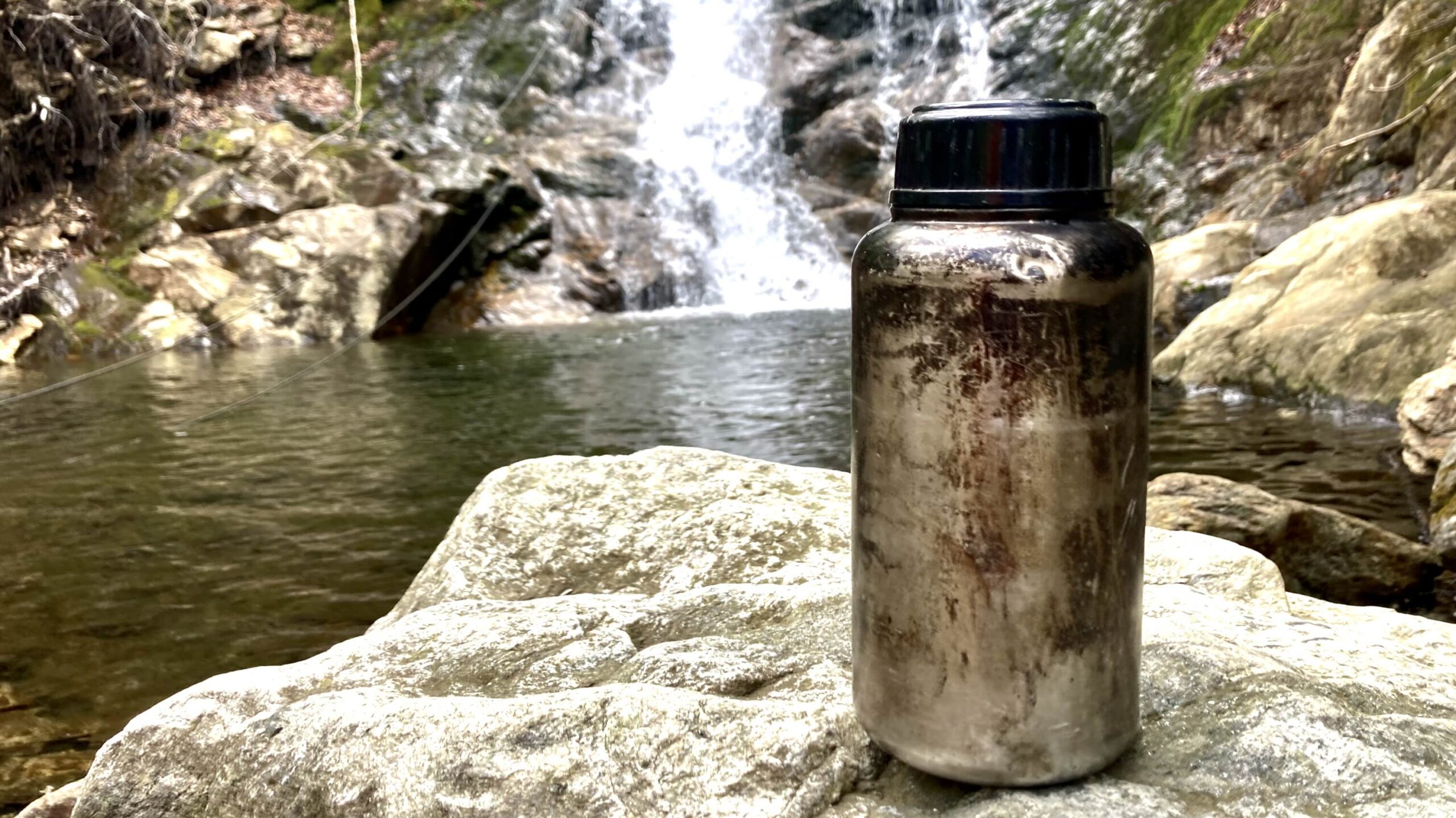Today will wrap up my EDC series talking about vehicle-carried EDC items. I’m going to showcase the stuff in my vehicle, but the point is to give you some ideas about what an effective vehicle-carried EDC system might look like.
This article contains affiliate links.
EDC Part 0 | EDC Part 1 | EDC Part 2 | Part 3
If you’ve read the other articles in my EDC series you know that I’m highly grounded in realism and my primary interest is in preparing for high-likelihood events. My car isn’t an armored “BOV” with a snorkel kit and a spare axle. There are no NFA items, Level IV plates, or breaching tools. The stuff in my car serves two primary purposes: keep the car going and keep the people in it going. This article will be organized around those two tenets.
Keep in mind also that my car “stuff” is supplemented by my other EDC stuff. I’m pretty hardcore about the “every day” in “every day carry.”
Vehicle EDC: Stuff to Keep the Car Going
Though an artificially supported one, your car is one of your single biggest assets in many types of emergency. It can serve as a weapon, as shelter and protection from the elements, a (really inefficient) generator to charge your electronics. Perhaps most importantly, it serves as a means of transportation for you, your family, and your belongings. Your vehicle can move you away from an area of danger (riot, chemical spill, hurricane) or to an area of safety or refuge (home, hospital, or unaffected region).
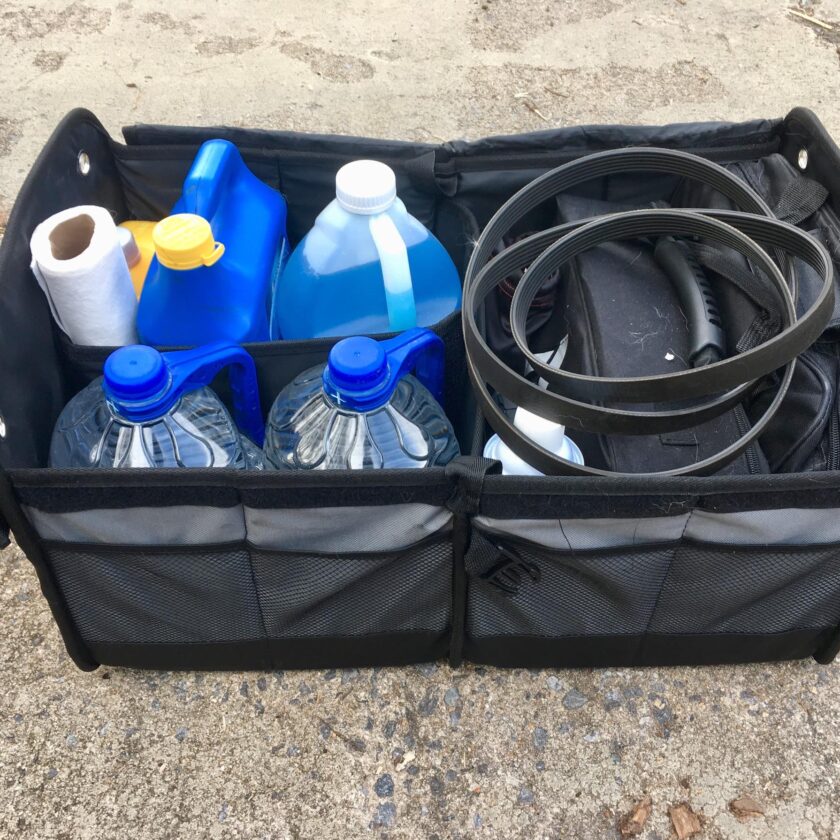
It makes sense to equip your vehicle with some tools and consumables to enable it to keep rolling. It constantly surprises me how many lists of this type I see that contain very little stuff to keep the car rolling. Most of my stuff is stored in “trunk organizer” similar to this one (it seems like a dozen different versions of the same thing are out there). My girlfriend bought it for me as a gift.
To be honest, I didn’t see the value of this thing until I had used it for a few weeks. I began to notice it was nice to have one place to check for all my preparedness “stuff.” Since she has one, too, we have identical organizers with almost identical contents in both of our vehicles.
Fuel
This one doesn’t go in the kit, but is the most important one on here – your car just won’t go without gas. I attempt to keep my fuel tank at least 1/2 full, and I start thinking about filling up when I drop below the 3/4 mark. Half a tank isn’t a lot of fuel; even with my relatively efficient SUV that only gives me a range (assuming clear highway and smooth sailing) of ~175 miles. . . but it’s a heck of a lot better than running on fumes.
The prepper motto is “half is the new empty.” I’m going to be completely honest with you: I’m not perfect. I don’t always achieve this, but I do 95% of the time. This is much easier for me now that I drive less. With the uncertainty we face right now, my guess is this is probably a lot easier to be disciplined about. Keep some fuel in your car, and have a can or two of gas around your house, if possible.
Preventative Maintenance Stuff
Spare fluids. I keep at least a “unit” of each of the following in the vehicle: engine oil, antifreeze/coolant, and windshield washer fluid. I focus on these fluids because they are the most likely to leak, be consumed, or otherwise need replacing. I don’t keep things like brake fluid because if my brake fluid is suddenly low. . . I probably have bigger problems.
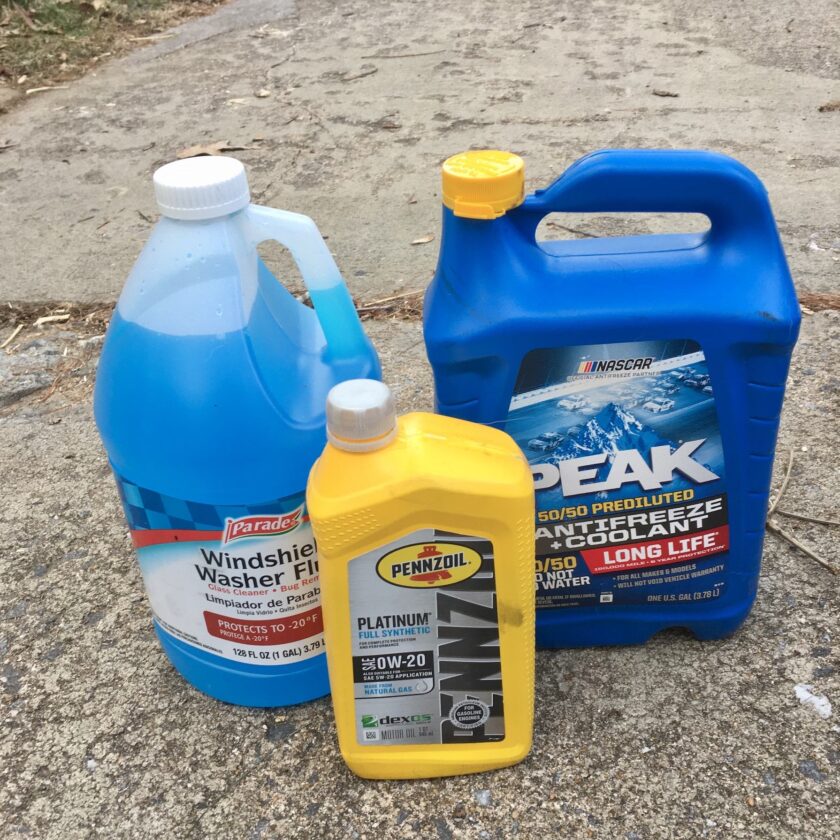
Regarding oil: make sure you have same makeup (conventional or synthetic) and weight as what is actually in your engine, and preferably the same brand. It’s not a good idea to mix oils in your engine. I became a “Penzoil man” not because of any brand loyalty. It’s just easy to find in full synthetic, in quarts and 5-quart bottles, for both of our vehicles at my local parts store. This standardization makes it easy for me to remember exactly what we use.
With antifreeze/coolant: it comes in a concentrate that you have to mix 50/50 with water, or prediluted that you can pour directly into your radiator. I prefer the prediluted stuff. Yes, I have the potential to make twice as much antifreeze with the concentrate, but I also gain the convenience and rapidity of not having to mix it with water on the side of the road.
Tire Pressure Gauge: This is a more important tool than most people realize. Your tire pressure directly impacts your vehicle’s handling, which directly impacts the safety of you and your family. It also impacts your vehicle’s on- and off-road efficiency and performance. If you aren’t checking your tire pressure, you probably should be. Your tire pressure gauge should go high enough to read your tires (some light-duty gauges only go up to 50 or so lbs, while some tires go up to 65+ psi).
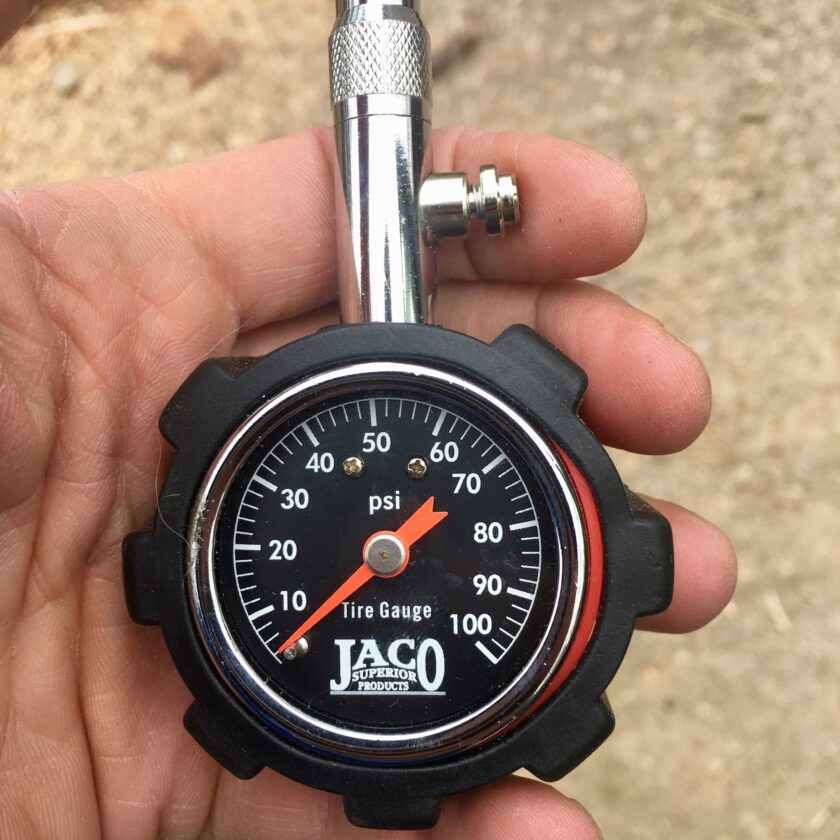
If you don’t know how to check your tire pressure or why you should, stay tuned. In the very near future I will definitely be talking about preventative vehicle maintenance.
Window Cleaning. This is definitely not a sexy one. I’m sure most of you probably expected to see pics of a suppressed SBR in .300 BLK instead of a can of glass cleaner and half a roll of paper towels. But you’re about a million times more likely to actually need clean glass between your face and the highway than you are an Aimpoint between you and a threat. The aerosol “Sprayway” stuff is awesome – it’s the best automotive glass cleaner I’ve ever seen. I also keep all the exterior glass in my car Rain-X’d as well.
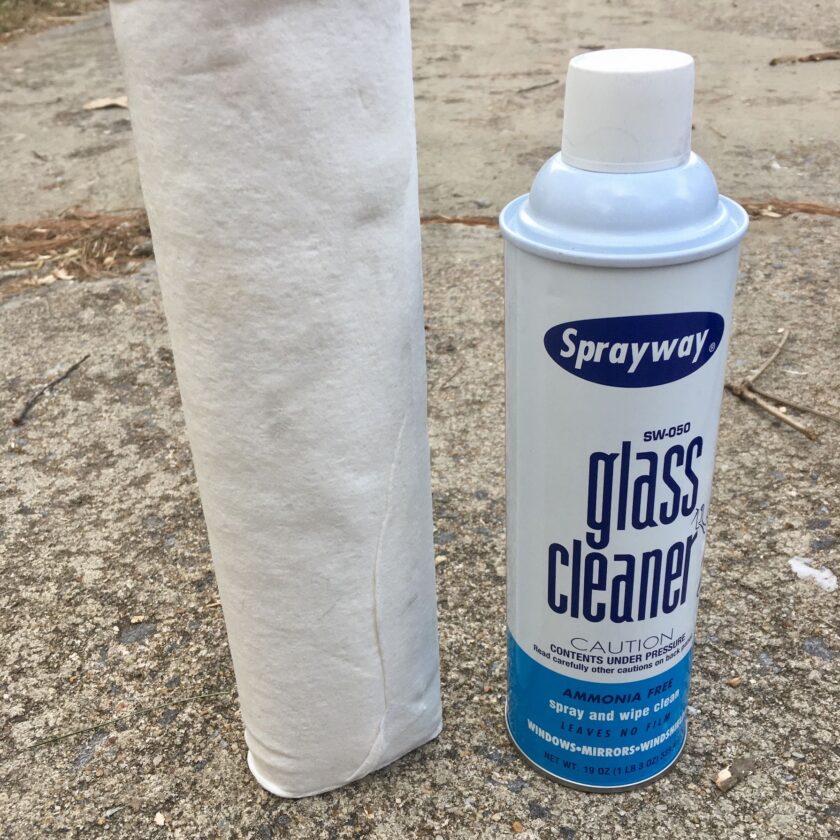
Recovery Stuff
Tire Repair. First and foremost: a jack, lug wrench (and security nut key, if you need one), and spare tire. Though the jack in your car will probably work, you can increase efficiency with a bottle jack or – even better – a Hi-Lift jack. I haven’t upgraded my jack yet. I have cut myself a 8×8″ piece of 1/2″ plywood as a platform for my jack. I highly recommend this to keep your jack from sinking into soft ground, or even hot asphalt.
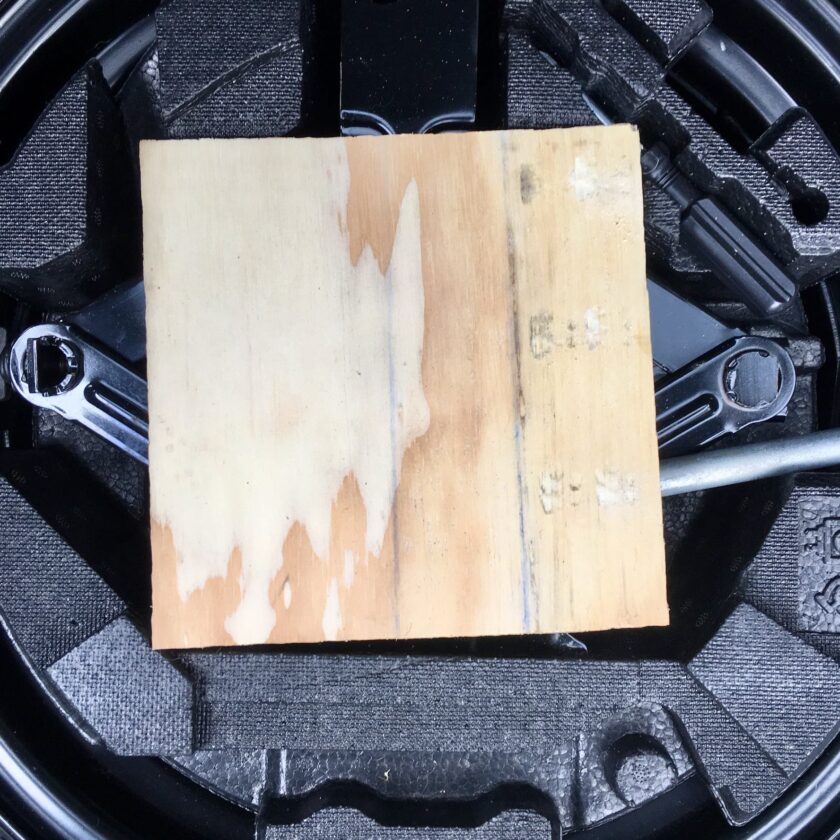
I greatly prefer a full-size spare tire – I would much, much rather throw a spare tire on that repair a tire on the side of the road. The spare tire/rim I have is the original tire/rim from when I had my lift-kit and steel rims put on. Your local mechanic can probably hook you up with an extra wheel (it might not be pretty) and a used but serviceable tire for under $100.
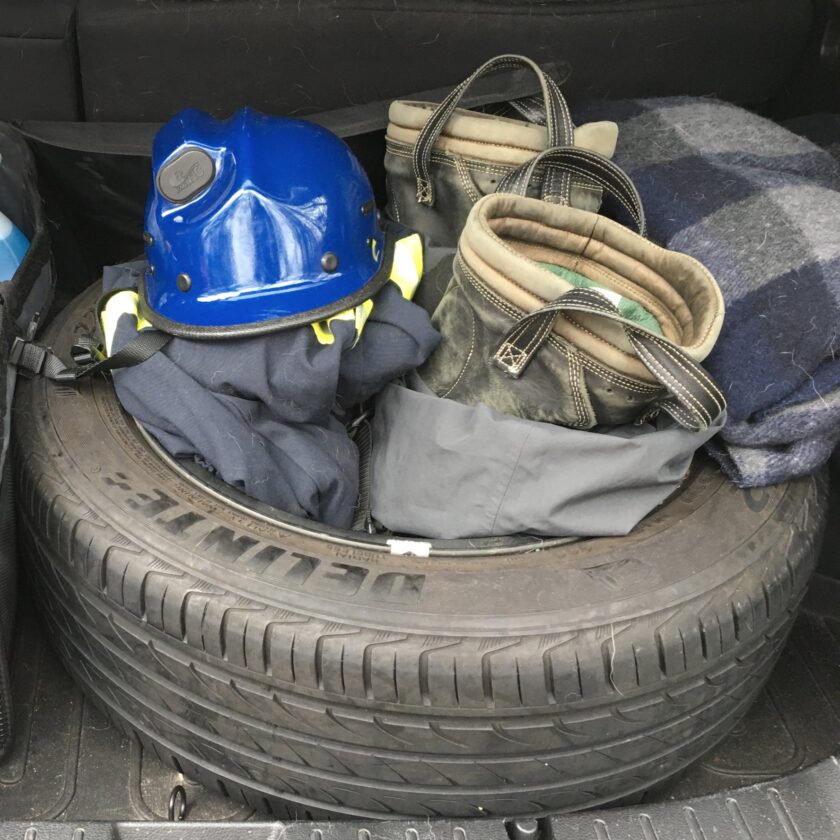
Even with a full-size spare there is the possibility that repairing a second (or third, or even fourth) tire might become necessary, so I keep some tools on hand to do so. Repairing a repairable tire isn’t all that difficult, assuming you have the correct tools and materials on hand. Without the correct tools and materials its pretty much impossible, so make sure you have the right stuff. At under $10, a tire repair kit isn’t that expensive or large/bulky, either. There’s not really a great reason NOT to have a tire repair kit in your vehicle.
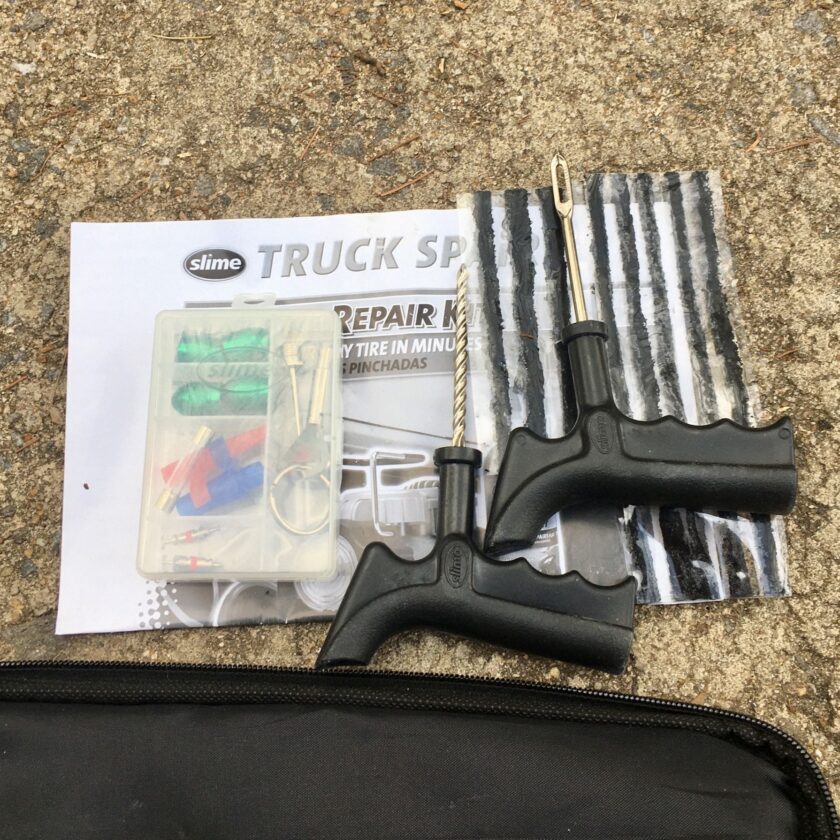
You will, however, have to have a way to reinflate your tire. The kit I have is from “Slime.” It comes with an mini air compressor and a bottle of tire-repair Slime. I purchased the standard tire-repair tools separately. This isn’t a perfect-world solution, but it’s only a backup to my full-size spare.
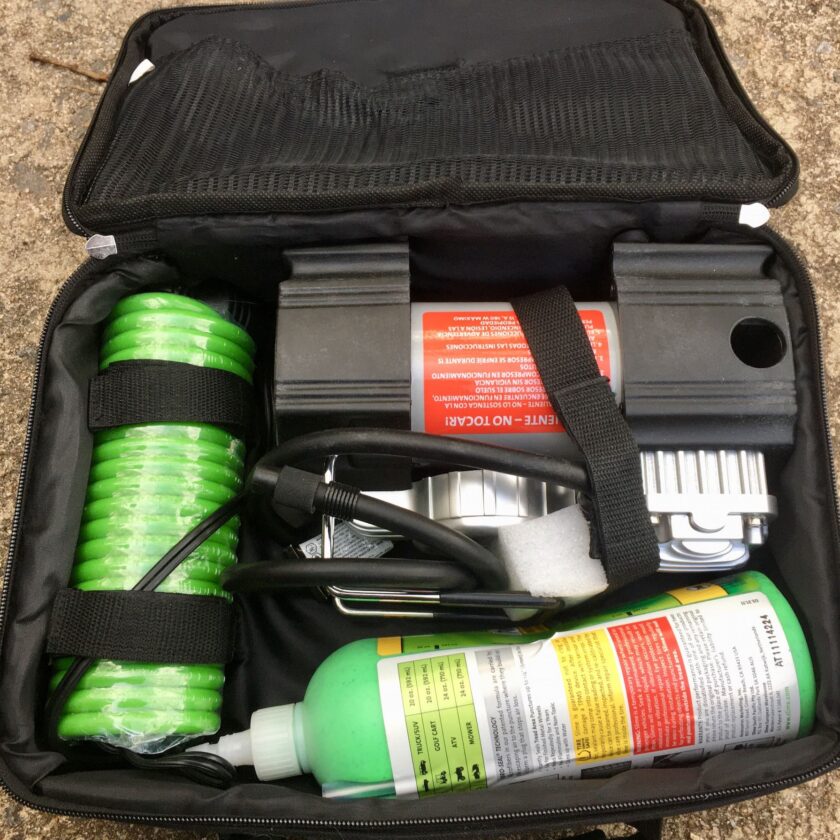
Recovery: Battery Jump-Start. There are basically two ways you can go here: jumper cables or a powerful battery that allows you to self-recover (and gives you a fairly deep battery bank in the event of power outages). I keep both in my car. I like the ability to help someone else in distress with jumper cables without reducing my own ability to self-recover. I am also still unsure of how much I trust the compact batteries (so far, so good, though).
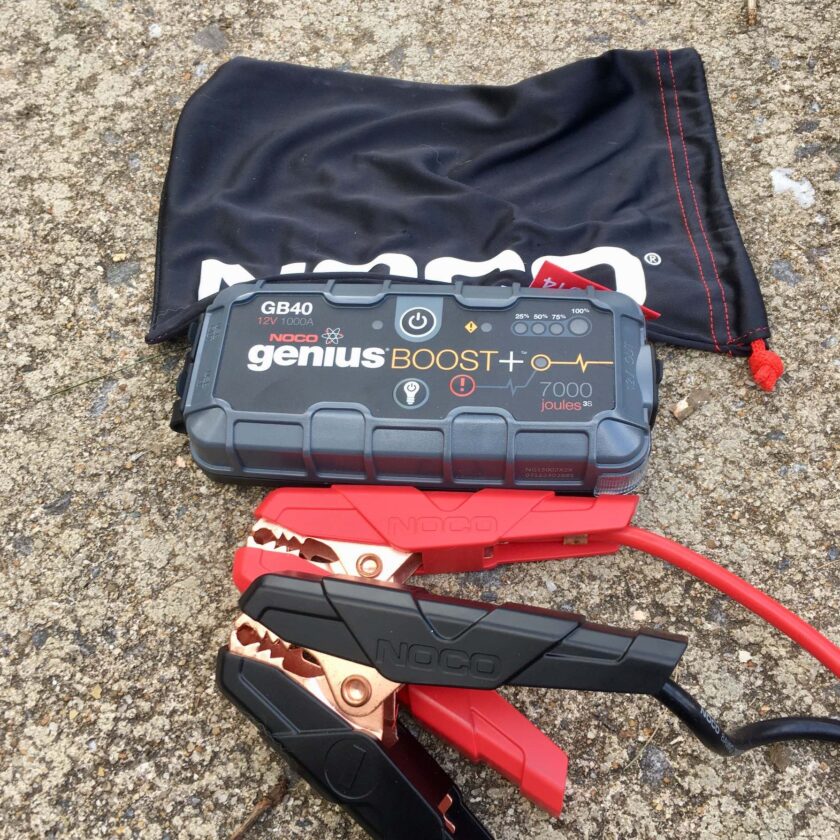
The battery I have in both cars is the Noco Genius Boost GB40. I’ll admit the recent reviews on Amazon aren’t encouraging. I have been very satisfied with both of ours, but you may want to do your own shopping around. In any case I ALWAYS keep a set of jumper cables in both cars. . . just in case.
Recovery: Tow Strap. Smaller, lighter, safer, and all-around better than a chain. You should definitely have a tow strap with shackles. The perfect-world solution would be a self-recovery option (aka: a winch) but that requires significant investment. As with jumper cables, your chances of finding someone to recover you skyrocket if you have the necessary equipment.
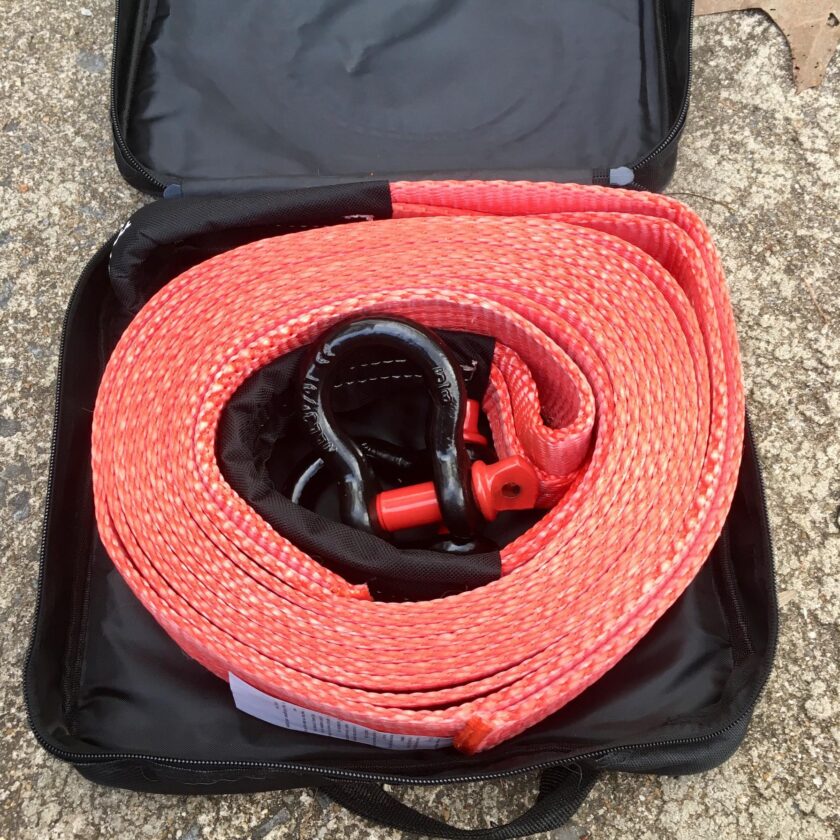
Tools
Tools is a very easy rabbit-hole to go down, but your tool selection should essentially be drive by your own abilities – not how much space you have in your vehicle. I am not a mechanic. I change my own oil, I swap out bulbs in our vehicles, and I could change out a belt if I had to. That’s about the extent of my mechanicing on our cars, so my tools reflect that. I have pairs of standard, needlenose, and channel lock pliers, and a little $30 tool kit from Craftsman.
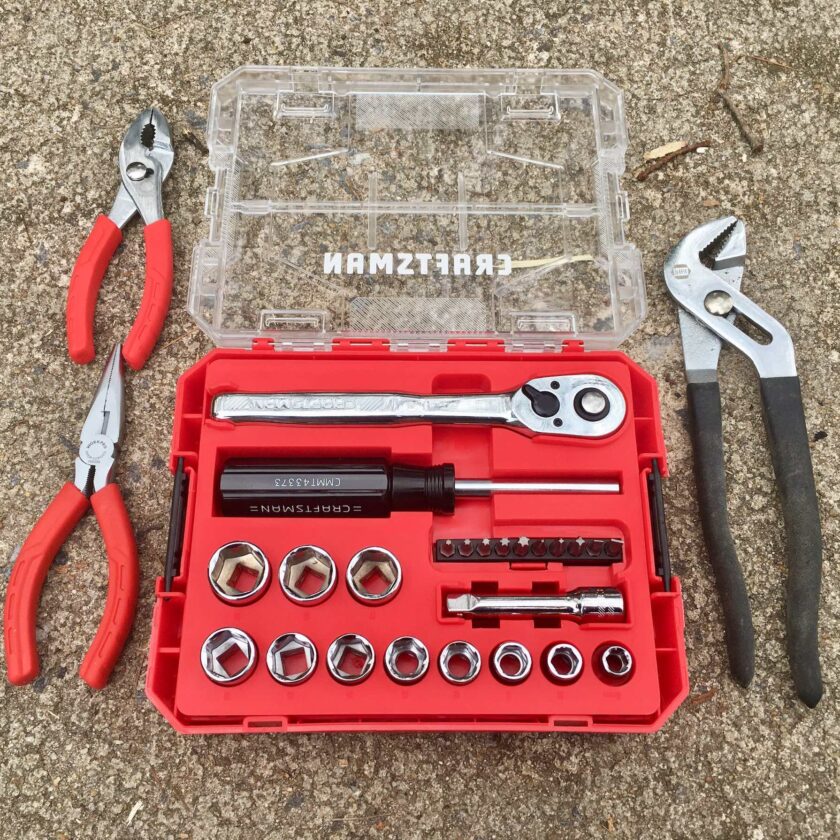
Some of you will laugh at my tool kit, and that’s OK. The 450-piece Craftsman set wouldn’t do me a whole lot of good, because I am limited by my own (lack of) skill. Keep in mind this kit is metric because my vehicle is metric; your mileage – no pun intended – may vary. Since these tools are useful for far more than just your car I’d recommend a slight upgrade to something like this (I was trying to save a buck and regret it if I’m being completely honest). Again, don’t go crazy, though. The more stuff that’s in your vehicle, the more stuff that can get stolen out of it.
Stuff to Keep Me Going
The “stuff for me” stuff is usually well represented in most internet vehicle kits. I do keep some of this stuff in the car. The car can easily carry items that add drastically to my capability. It would be dumb to completely overlook some personal items.
Water: Holy shit! I can’t believe how many vehicle equipment inventories I’ve seen online that only have a couple 16- or 20 ounce bottles of water. Water is ESSENTIAL TO YOUR CONTINUED EXISTENCE! I keep two gallons in both our cars. If you don’t have some water in your car I would strongly recommend you get some ASAP. I would recommend getting something in a durable bottle, protecting it from light, and replacing it if you open it. Sealed bottles should be good for a very long time.
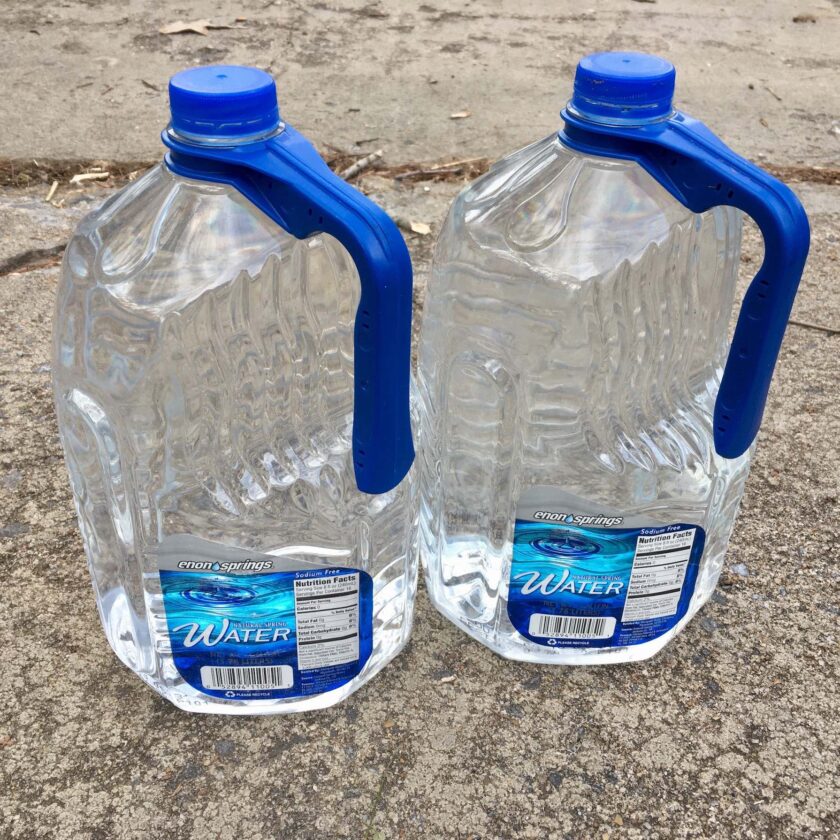
First Aid Kit: If I happen upon a car accident I don’t want to use the first aid kit out of my APEC bag. Why not? First of all, that stuff is for use on me and mine. Secondly, it would take a bit longer to get to; the car kit is optimized for “grab ‘n go.” It’s mostly a SOF tourniquet (not an affiliate link; please don’t purchase tourniquets on Amazon!), gloves, and a ton of gauze for wound packing/dressing.
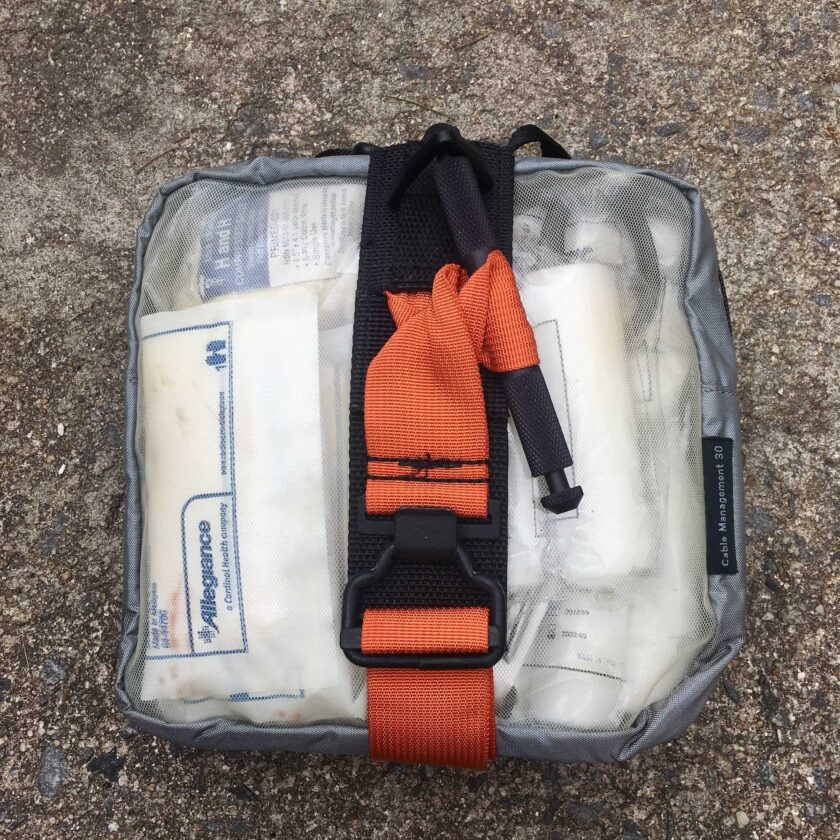
Blanket: I always keep a wool blanket in the car. Blankets are another item that are useful for a lot of things. I’ve told this story many times before but I was in Boston when thousands of people got trapped on the highway for up to 24 hours. You think they wished they had a blanket? Your blanket can also be used to keep your clothes clean if you need to change a tire, cut into bandages, used to make a hasty litter, etc.
Deficiencies
What am I missing? Most importantly, a fire extinguisher. It’s funny – we have four fire extinguishers in the house, but I haven’t gotten around to putting one in my vehicle. Expect to see that corrected soon.
There are a million other things I could put in the car: fuses, bulbs, spare parts, more tools, etc. I feel like I’ve struck a solid balance for myself based on space availability, cost, and I’m not over- or under-equipping myself for my own capabilities. More than anything, I simply hope this gets you thinking about your vehicle and the stuff that’s in it.
Vehicle Title
This one isn’t stored inside the vehicle but it’s worth talking about: the title. I hold it. I never borrowed money from the bank to purchase my car. I saved up – like my parents taught me and your parents probably taught you – and I bought it outright. I didn’t buy it new; it was about 5 years old when I got it. This will probably offend some people, but: if you’re paying $600 or $700 or $800 a month on a vehicle, getting rid of that payment should be one of your very first preparedness priorities. Does having a $50,000 vehicle make your life 5 times better than having a $10,000 vehicle? I kind of doubt it.
Closing Thoughts
I’m sure my setup isn’t perfect, and I still consider it a work in progress. Do you need all of this stuff? Honestly, probably not and you can tailor your setup to your needs – this is just some food for thought. However, I recommend you take a hard look at what you’re carrying in your car. If you have NVGs and only 16 ounces of water? You might want to reassess your needs. If you have a case of MREs but not a drop of spare fluids? Again, so reassessment might be in order. Make sure your vehicle continues to be an asset by having some necessary supplies to keep it rolling.



